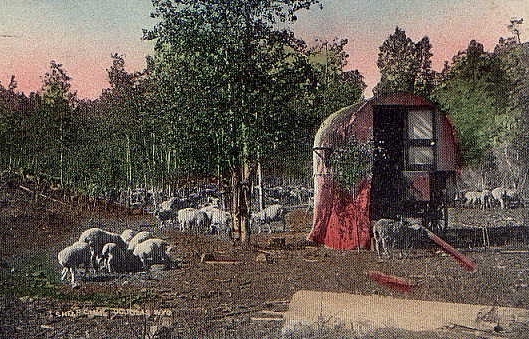
Sheepcamp near Douglas, cir. 1900
Although in the popular mind Wyoming is mostly associated with
cattle, the cattle count having increased from 8,000 in 1870 to 1,500,000 in 1885, the impact
of the "Great Die Off" discussed with regard to Chugwater was
an increased emphasis on a change from cattle to sheep. Even the Two Bar made the change. This is not to say,
however, that sheep did not have an importance before 1886.
The 1880 census reflected a sheep count of over 500,000 and by the
mid 1880's there were some 106,000 sheep in Albany County alone. In contrast
the 1870 census reflected only 6,409 sheep in the entire territory.
The Warren Livestock Company,
still in business, was founded by Francis E. Warren in 1874. In 1894 the Company had
an inventory of 1,826 horses, 26 mules, 3,220 head of cattle and 63,433 sheep. In addition
to Gov. Warren, other governors had an interest in sheep including Eugene Osborne and
B. B. Brooks. This is not to say that prior to the winters of 1886 and the winter of 1888-89, that
Warren did not have an interest in cattle. Warren at one time had an interest in
cattle in the Dakotas and with M. F. Post owned the Spur Ranch at LaBarge in the
Green River Valley. Prior to the winter of 1888-89, the Spur Ranch had 15,000 head of
cattle. That winter, as in the Winter of 1886, deep snow was followed by a thaw and then a
freeze, creating a ice sheet through which the cattle could not graze.
The following spring at round-up only 800 cattle were accounted for.
Jim Mickelson, foreman of the Spur, noted the effect at his own homestead. He described
his being able the following spring to step from frozen carcass to frozen
carcass. Smaller ranchers suffered the same losses. Ed Steele lost all but 8 of
his 87 head.
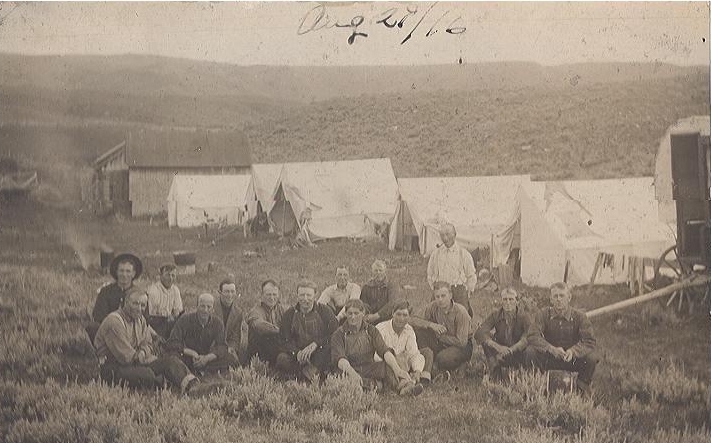
Along Nowood Creek, August, 1916
Note sheep wagon at right side of photo.
Only 7 years before the above photo, on April 2, 1909, the last armed conflict between cattlemen and sheep growers
occured in the Nowood Valley at Spring Creek, 7 miles southeast of Ten Sleep. In the
"Spring Creek Raid," seven masked riders raided Joe Allemand's sheep camp,
killing
Allemand, his nephew Joe Lazier and Jules Emge and burning their two sheep wagons. The raid was supposedly motivated by
Allemand's bringing his herd of 5,000 sheep into the Nowood Valley which cattle
interests had declared off limits to sheep. (Webmaster's note: The usual rule is,
"Fence sheep in, fence cattle out.") In November 1909, Herbert Brink,
Tommy Dixon, Milton Alexander, George Henry Saban, and Ed Eaton, local
cowboys, were brought to trial in Basin for participation in the killings. Two others,
Charles Ferris and Albert Keyes turned state's evidence and were not charged. Brink was
convicted of first degree murder. Alexander and Saban were convicted of
second degree murder. Dixon and Eaton each plead guilty to arson. Eaton died
in state custody. Saban escaped in 1913 and was never recaptured. Dixon was
paroled in 1912. Brink and Alexander were paroled in 1914. The
public reaction to the raid resulted in the ending of such violence on the open range. An historical
monument now marks the site of the raid.The Spring Creek raid was, however,
not the only incident of such violence, it was merely the last. "Sheep dead lines," such
as that in the Nowood Valley, were proclaimed by other cattlemen. The Spur Ranch declared
a dead line across the Little Colorado Desert from the mouth of
Fontenelle Creek to Farson, north of which no sheep were permitted. In southwest Wyoming along
the Green River a "sheep war" raged at the turn of the century. Ultimately,
however, with the decline of cattle and the rise of the sheep industry, even
the Spur switched to sheep.
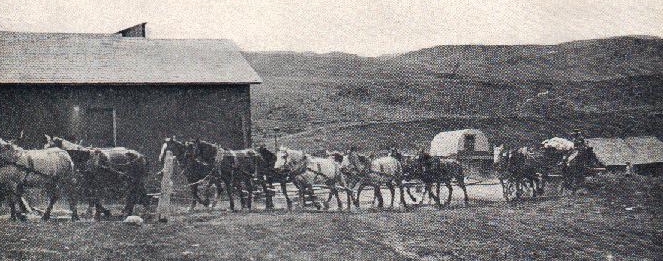
12-horse hitch, Nowood.Note
the sheep wagon in the background. Sheep wagons were supposedly
invented by Rawlins blacksmith James Candlish in 1884. Around 1900, Schulte
Hardware Company of Casper standardized the wagon as 11 feet long and 6 1/2 feet wide, canvas top and
stove. By 1904, sheep wagons were being manufactured in the Big Horn Basin by
D. V. Bayne of Thermopolis. The wagons later could be purchased from,
among others the Studebaker Brothers of Southbend, Indiana. Some are still in use
in the Big Horn Basin.
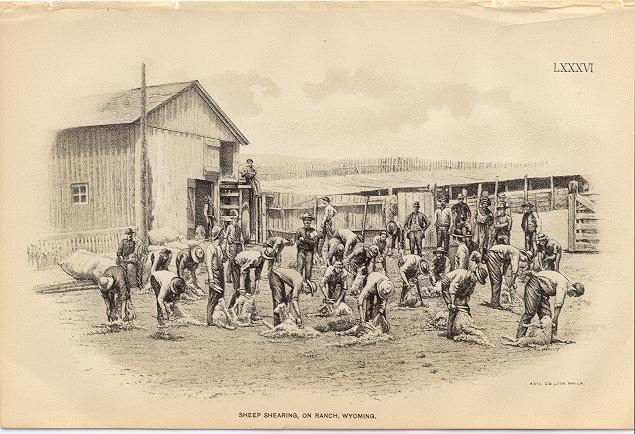
Sheep Shearing, 1892
The sheep industry started in southern Wyoming in the 1870's along the UPRR.
The coming of the railroad also led to large sheep drives from Oregon to the
Wyoming along the old Oregon Trail. On some drives in the 1880's as many as
20,000 sheep would be trailed to Rawlins. Even after the construction of the Oregon Short Line, discussed
with regard to Kemmerer, sheep would be trailed from Oregon rather than be entrained.
Even within the state trailing sheep remained the general means of transport. In
1928, as an example, a herd of 1500 sheep purchased from the Yellowstone Sheep Company was
trailed from Hudson to Douglas even though the railroad was available. The reason was simple,
as depicted in photos on the next page,
one sheepherder with a dog and a sheepwagon, could herd as many as two thousand sheep. By 1910
there were over 5 1/2 million sheep in the state. With the growth of the wool industry new
methods were introduced. As pictured below, In approximately 1917, John B. Okie, owner of
the Big Horn Sheep company of Lost Cabin,
introduced the "Australian system" of sheep shearing into the state.
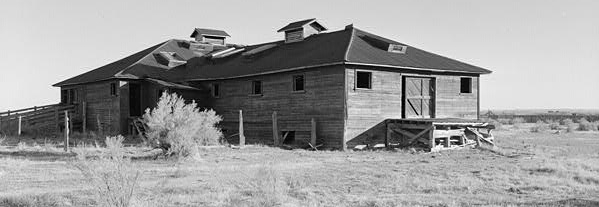
Sheep shed, Big Horn Sheep Company, Lost Cabin
Under the Australian system, shearing is done in a sheep shed rather than in an open corral as depicted above. As
illustrated in the next photo,
sheep are placed in one room and put into a pen with five sheep each. There,
the sheep are mechanically sheared and shoved out a door at the end of the
pen to be inspected and let go to pasture.
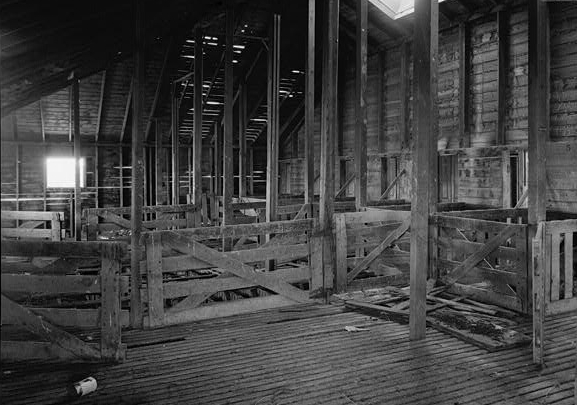
Interior sheep shed, Big Horn Sheep Company
Sheepherding continued on next page.
|







